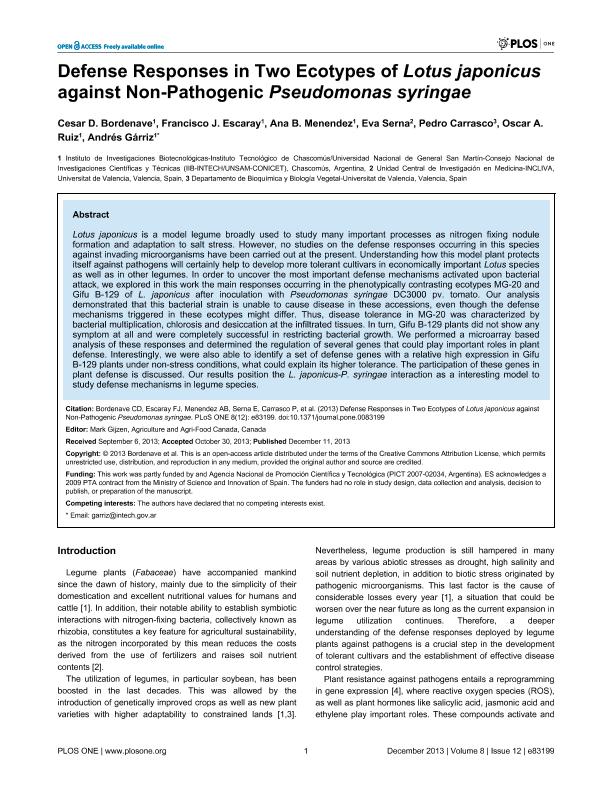Mostrar el registro sencillo del ítem
dc.contributor.author
Bordenave, César Daniel

dc.contributor.author
Escaray, Francisco José

dc.contributor.author
Menendez, Ana Bernardina

dc.contributor.author
Serna, Eva
dc.contributor.author
Carrazco, Pedro
dc.contributor.author
Ruiz, Oscar Adolfo

dc.contributor.author
Gárriz, Andrés

dc.date.available
2015-10-05T19:08:58Z
dc.date.issued
2013-12-11
dc.identifier.citation
Bordenave, César Daniel; Escaray, Francisco José; Menendez, Ana Bernardina; Serna, Eva; Carrazco, Pedro; et al.; Defense Responses in Two Ecotypes of Lotus japonicus against Non-Pathogenic Pseudomonas syringae; Public Library of Science; Plos One; 8; 12; 11-12-2013; 83199-83199
dc.identifier.issn
1932-6203
dc.identifier.uri
http://hdl.handle.net/11336/2324
dc.description.abstract
Lotus japonicus is a model legume broadly used to study many important processes as nitrogen fixing nodule formation and adaptation to salt stress. However, no studies on the defense responses occurring in this species against invading microorganisms have been carried out at the present. Understanding how this model plant protects itself against pathogens will certainly help to develop more tolerant cultivars in economically important Lotus species as well as in other legumes. In order to uncover the most important defense mechanisms activated upon bacterial attack, we explored in this work the main responses occurring in the phenotypically contrasting ecotypes MG-20 and Gifu B-129 of L. japonicus after inoculation with Pseudomonas syringae DC3000 pv. tomato. Our analysis demonstrated that this bacterial strain is unable to cause disease in these accessions, even though the defense mechanisms triggered in these ecotypes might differ. Thus, disease tolerance in MG-20 was characterized by bacterial multiplication, chlorosis and desiccation at the infiltrated tissues. In turn, Gifu B-129 plants did not show any symptom at all and were completely successful in restricting bacterial growth. We performed a microarray based analysis of these responses and determined the regulation of several genes that could play important roles in plant defense. Interestingly, we were also able to identify a set of defense genes with a relative high expression in Gifu B-129 plants under non-stress conditions, what could explain its higher tolerance. The participation of these genes in plant defense is discussed. Our results position the L. japonicus-P. syringae interaction as a interesting model to study defense mechanisms in legume species.
dc.format
application/pdf
dc.language.iso
eng
dc.publisher
Public Library of Science

dc.rights
info:eu-repo/semantics/openAccess
dc.rights.uri
https://creativecommons.org/licenses/by/2.5/ar/
dc.subject
Lotus
dc.subject
Japonicus
dc.subject
Pseudomonas
dc.subject
Syringae
dc.subject
Stress
dc.subject
Biotic
dc.subject
Transcriptomic
dc.subject.classification
Ciencias de las Plantas, Botánica

dc.subject.classification
Ciencias Biológicas

dc.subject.classification
CIENCIAS NATURALES Y EXACTAS

dc.subject.classification
Inmunología

dc.subject.classification
Medicina Básica

dc.subject.classification
CIENCIAS MÉDICAS Y DE LA SALUD

dc.title
Defense Responses in Two Ecotypes of Lotus japonicus against Non-Pathogenic Pseudomonas syringae
dc.type
info:eu-repo/semantics/article
dc.type
info:ar-repo/semantics/artículo
dc.type
info:eu-repo/semantics/publishedVersion
dc.date.updated
2016-03-30 10:35:44.97925-03
dc.journal.volume
8
dc.journal.number
12
dc.journal.pagination
83199-83199
dc.journal.pais
Estados Unidos

dc.journal.ciudad
San Francisco
dc.description.fil
Fil: Bordenave, César Daniel. Consejo Nacional de Investigaciones Científicas y Técnicas. Centro Científico Tecnológico La Plata. Instituto de Investigaciones Biotecnológicas - Instituto Tecnológico Chascomús. Instituto de Investigaciones Biotecnológicas (sede Chascomús); Argentina
dc.description.fil
Fil: Escaray, Francisco José. Consejo Nacional de Investigaciones Científicas y Técnicas. Centro Científico Tecnológico La Plata. Instituto de Investigaciones Biotecnológicas - Instituto Tecnológico Chascomús. Instituto de Investigaciones Biotecnológicas (sede Chascomús); Argentina
dc.description.fil
Fil: Menendez, Ana Bernardina. Consejo Nacional de Investigaciones Científicas y Técnicas. Centro Científico Tecnológico La Plata. Instituto de Investigaciones Biotecnológicas - Instituto Tecnológico Chascomús. Instituto de Investigaciones Biotecnológicas (sede Chascomús); Argentina
dc.description.fil
Fil: Serna, Eva. Universidad de Valencia; España
dc.description.fil
Fil: Carrazco, Pedro. Universidad de Valencia; España
dc.description.fil
Fil: Ruiz, Oscar Adolfo. Consejo Nacional de Investigaciones Científicas y Técnicas. Centro Científico Tecnológico la Plata. Instituto de Investigaciones Biotecnológicas - Instituto Tecnológico Chascomús. Instituto de Investigaciones Biotecnológicas (sede Chascomús); Argentina
dc.description.fil
Fil: Gárriz, Andrés. Consejo Nacional de Investigaciones Científicas y Técnicas. Centro Científico Tecnológico La Plata. Instituto de Investigaciones Biotecnológicas - Instituto Tecnológico Chascomús. Instituto de Investigaciones Biotecnológicas (sede Chascomús); Argentina
dc.journal.title
Plos One

dc.relation.alternativeid
info:eu-repo/semantics/altIdentifier/url/http://journals.plos.org/plosone/article?id=10.1371/journal.pone.0083199
dc.relation.alternativeid
info:eu-repo/semantics/altIdentifier/url/http://www.ncbi.nlm.nih.gov/pmc/articles/PMC3859661/
dc.relation.alternativeid
info:eu-repo/semantics/altIdentifier/doi/http://dx.doi.org/DOI:10.1371/journal.pone.0083199
Archivos asociados
